|
| |
Scroll
down for the next maps for Duke
Links: Claws --
Conomo
-- Goody
-- Homer -- Meadow --
L.R.
-- Mittark --
Penelope -
Birds
of Prey page -- Osprey
main page --
Migration08 -- Migration
page -- Home
Page
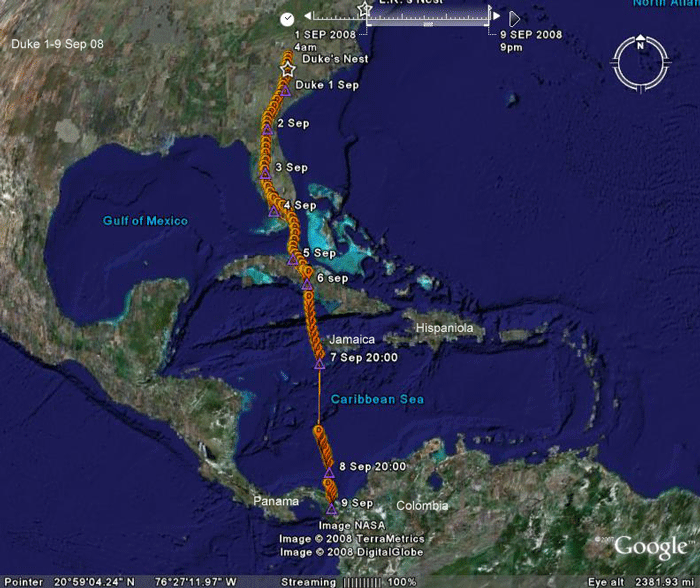 |
Travels so far.
9 Sep 08.
Duke made the 850 mi (1,400
km) crossing of the Caribbean Sea without a hitch. That would include
without hitchhiking on a ship, which some birds do.
He arrived in Panama probably around 21:30 on the 8th
about 36 hours after leaving Cuba. Over the 36 hours, he averaged about
24 mph (38 kph). On the first leg of the trip he had some strong tail
winds, thanks to Hurricane Ike. His ground speeds on the 7th were 30 mph
(50 kph) or higher.
His GPS unit was off when he made landfall, probably
around 21:30 on the 8th. We don't know where he spent the night.
Almost all adults we have tracked traveling to South
America take a left (turn east) in Cuba and hop over to Hispaniola
before making the crossing to S.A. On that route, they only have to
cross about 350 mi (560 km) of open water.
Unfortunately, this is as far as we were able to track
Duke. Our last signals from him were on 9 Sept.
Scroll down for details of his travels and our
speculation on what might have happened. |
|
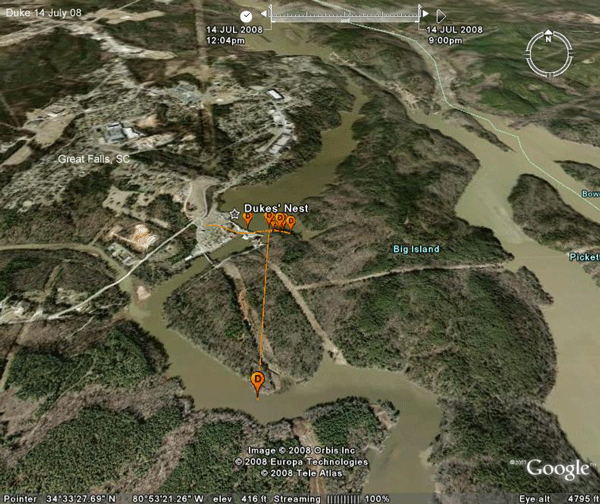
|
14
July 08.
Here are the first locations
for Duke on the day he was tagged.
He was captured right next to the first hydroelectric
dam built by Duke Energy. The cluster of points is where he and his sibs
hang out waiting for Mom, Dad, or their second Dad to bring home a fish. Two
males were feeding this brood, a phenomenon never before observed in
Ospreys.
|
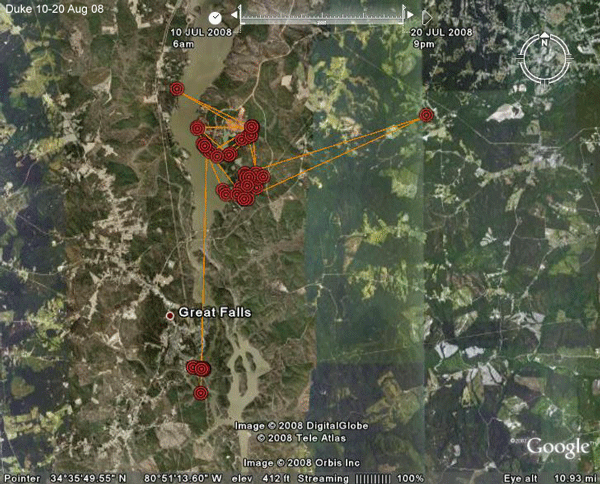 |
10-20 Jul 08. Duke seems to have abandoned the nest area
only a few days after we trapped and tagged him. Bill Price, who knows this
pair very well, tells me that this is the same behavior he's witnessed in
the previous two years' nests. The young birds rarely come back to the nest
once they fledge (this made me nervous when we set up to trap a bird). In
previous years, and apparently this one as well,
they move upstream to the larger Fishing Creek Lake not long after fledging. After seeing this map, I suspected
that we might have caught a young bird from a different nest, but Bill
assures me that this is what the Great Falls family does each year. |
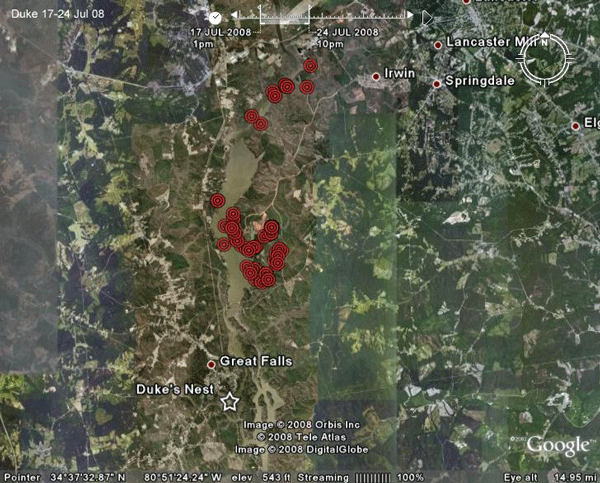 |
17-24
July 08.
Duke has abandoned the old
homestead and moved fulltime upstream to
Fishing Creek Lake. Could there be a better place for an Osprey? |
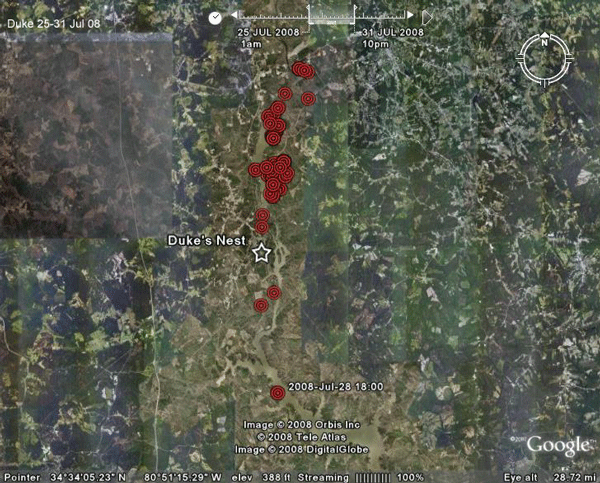 |
25-31
July 08.
Duke took a daytrip on the
28th to check out Lake Wateree. He decided it was not up to his standards
and retreated to his favorite fishing holes around Fishing Creek Lake. |
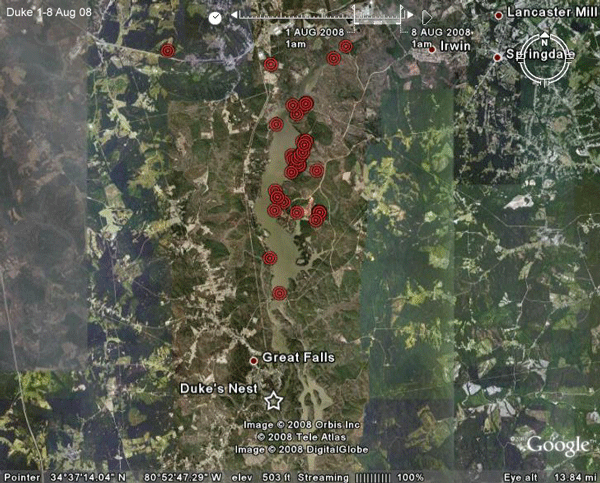 |
7
Aug 2008.
Still hanging around Fishing
Creek Lake. The point in the upper left had him travelling about due west, so he
has been somewhere out beyond the points shown here. |
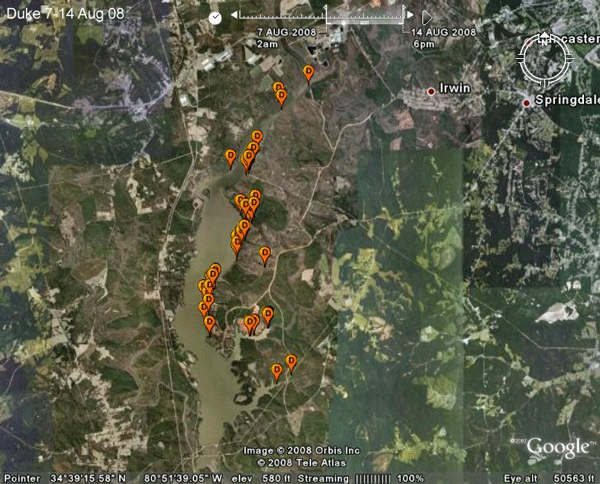 |
7-14 Aug 08. Duke continues to
fish the east side of Fishing Creek Lake. |
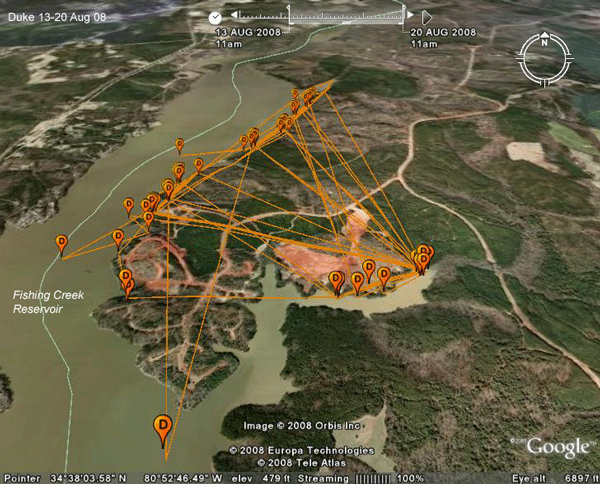 |
13-20 Aug 08.
More of the same. |
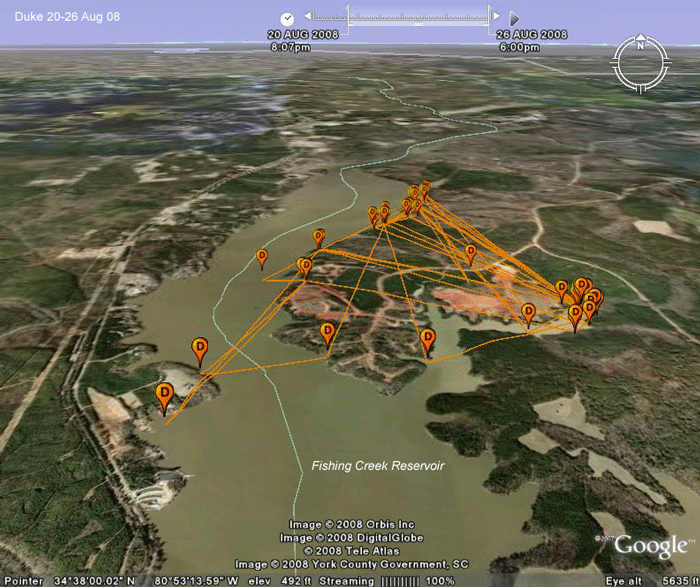 |
20-26 Aug 08.
The fishing must be good here. Duke should be heading south soon.
(Famous last words!) |
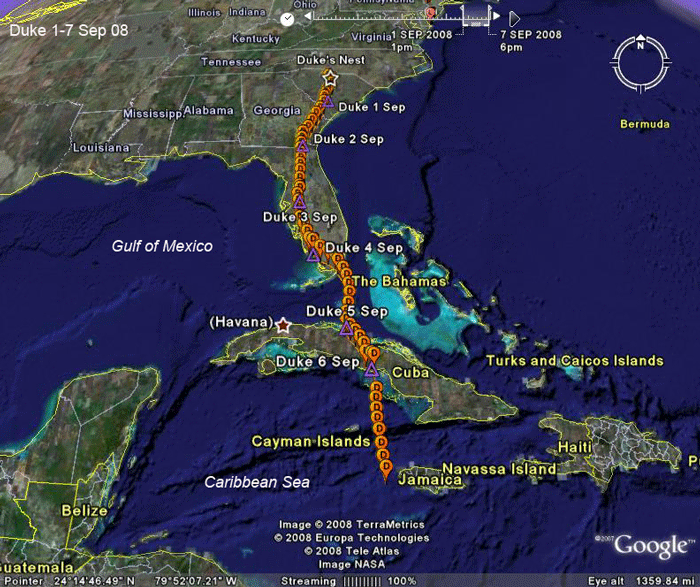 |
1-7 Sep 08.
For once a prediction is right! Duke took off for points south on the
1st of September. Unlike Goody and Meadow, Duke apparently read the
migration manual before leaving home. During his first 6 days of
migration, he covered 987 mi. (1588 km). He is averaging 164 mi. (165
km)/day.
In the images below, you'll see his trip in more
detail. |
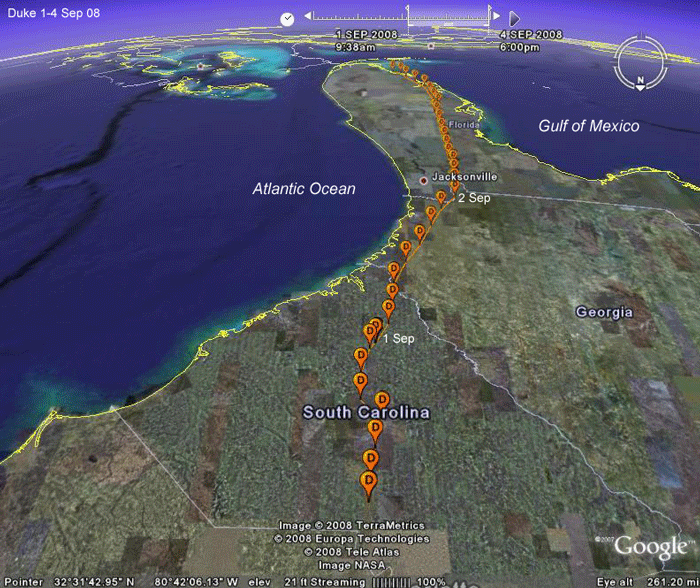 |
1-3 Sep 08.
Don't get dizzy--we've spun around and are looking south.
Duke spent his first night on migration in southern
South Carolina. A day later he spent the night just across the GA/FL
border west of Jacksonville. |
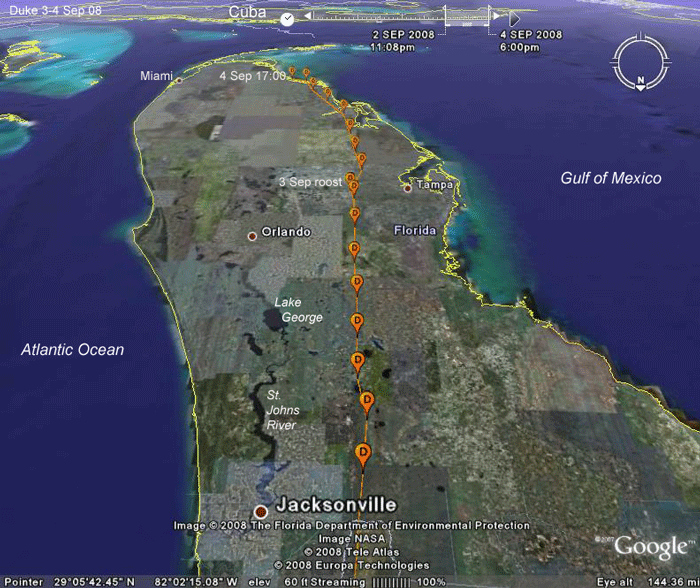 |
3-4 Sep 08.
Duke took care of most of Florida in two days. He passed west of the St.
Johns River, a favorite stopover for both north- and south-bound Ospreys
on their migration, as well as plenty of residents, en route to his
night camp east of Tampa.
On the 4th he made it to the west coast due east of
Miami. |
 |
4 Sep 08.
Duke arrived in the Ten Thousand Islands on Florida's west coast in the
afternoon of the 4th and spent the night. This has to be a great spot to
fill up the tanks. |
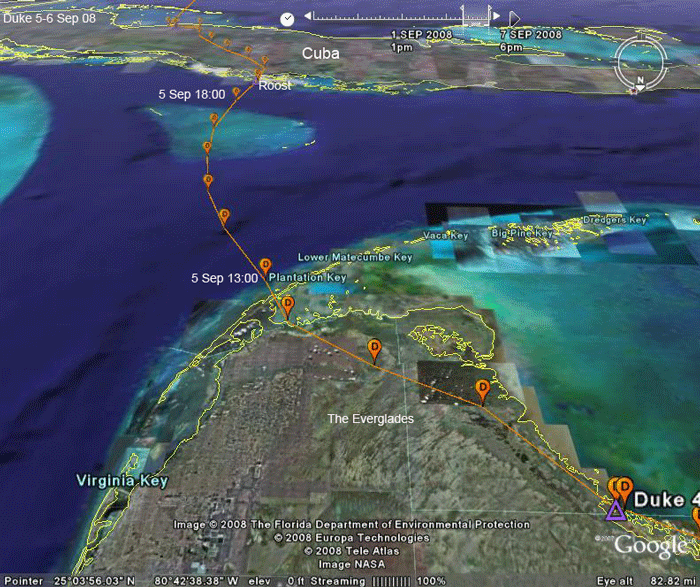 |
5 Sep 08.
It took just a bit over 6 hours to get to Cuba. He averaged only 23 mph
(37 kph) on the trip and did it close to the water.
He settled down for the night right on Cuba's north
coast. At this point, he's clocked 864 mi. (1,391 km) on the
Ospreyometer. |
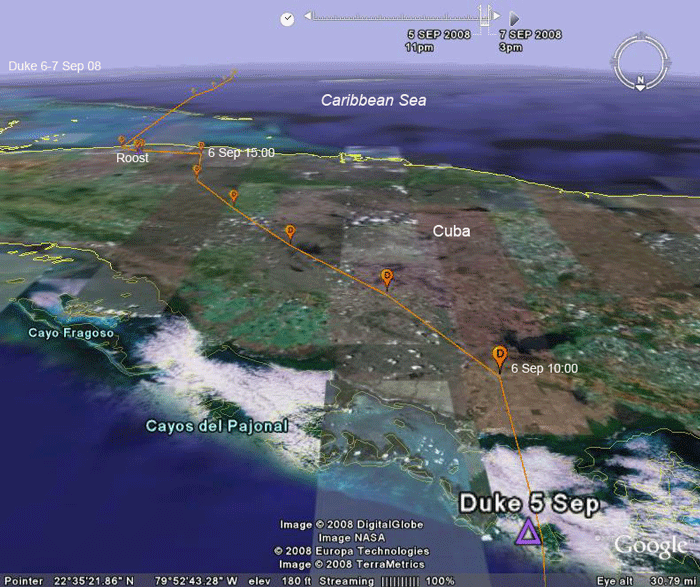 |
1-7 Sep 08.
Duke took 6 hours to cover most of Cuba (at least the north-south part).
He was traveling quite slowly (about 18 mph) from 10:00
to 15:00.
He settled down around 16:00 south east of Sancti
Spiritus.
He seemed to have settled down by 19:00, but an hour later
was 6 mi. closer to the coast.
Duke took off on his first real migration test. On his
current trajectory, he will have to fly over 850 mi. (1,366 km) without
resting before arriving in Panama.
And we have to wait 3 days to see if he'll make it! |
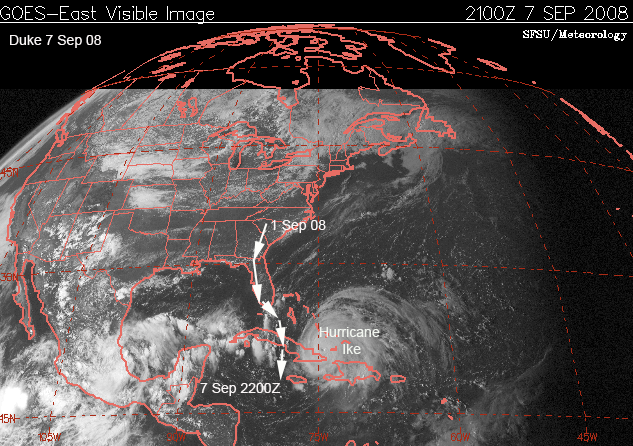 |
7 Sep 08.
Duke took off just before the massive Hurricane Ike plowed into Cuba.
The time on the satellite image and the current point
on his migration are "Zulu" or Greenwich time, which is 5 hours
ahead of Cuba time.
And once again, we see a juvenile not taking the safer
route to Hispaniola and then to South America, where the water crossing
is only 350 mi. (570 km). |
 |
9 Sep 08.
(The missing map) Duke made it to Panama sometime around 11PM on the
8th. He left Cuba around 07:00 on the 7th, so he was on the wing for
about 40 hours. |
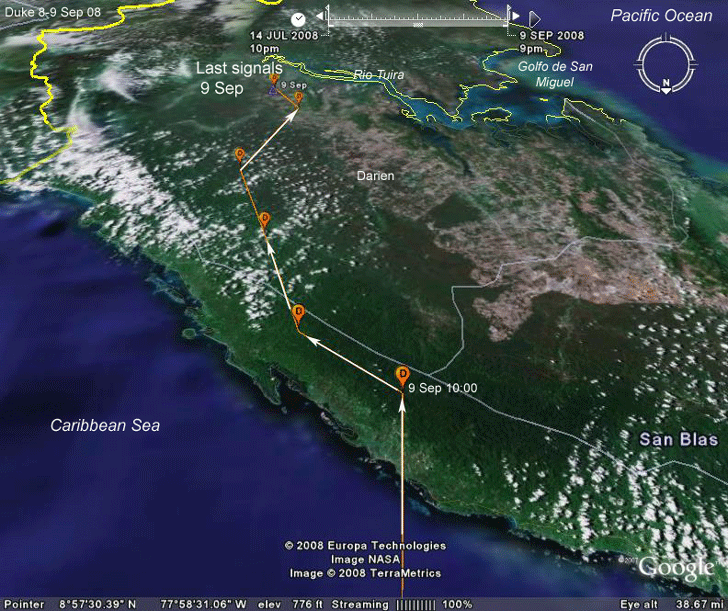 |
9 Sep 08.
(Looking south again here.)
After resting near the coast, Duke moved
about 60 mi (100 km) into Panama on the 9th.
These were the last signals we received from his
transmitter.
He was in Panama in Darien
State. His next stop would have been the Darien Gap, the pass through the northern most
extension of the Andes that leads to South America.
This one is a real mystery. There is some agriculture
in the vicinity of his last signals, but not a lot. Shooting by hunters
is often a possibility when a bird goes missing on us. Based on the
apparent low density of humans in the area, this seems unlikely to me.
Noted Osprey biologist Roy Dennis has seen birds
arriving in Scotland so exhausted from struggles through bad weather
that they were unable to hunt and were found starving. As best we can
tell, there was no big storm in the area (he got out of Cuba in front of
Hurricane Ike and should have had tailwinds for part of the trip, at
least), so this is a possible explanation, but not overwhelmingly
convincing.
Predation cannot be ruled out. There are large and
powerful raptors in the Central American rainforest that could pose a
threat. Recently, a photograph of a Peregrine Falcon feeding on an adult
Osprey circulated on the web, so we know that birds of prey even as
large as an Osprey may fall victim to even more powerful predators.
Transmitter failure is an explanation we optimists rely
on when the evidence is as inconclusive as this.
Duke's disappearance will remain an unsolved mystery. |
| |
|
| |
|
Birds
of Prey page -- Osprey
main page -- Migration
page -- Home
Page
|